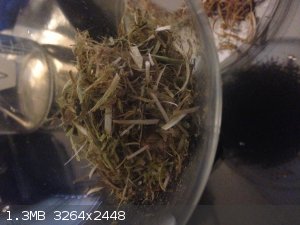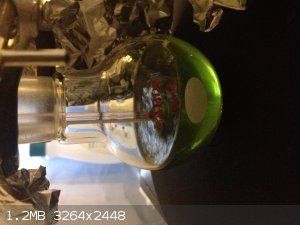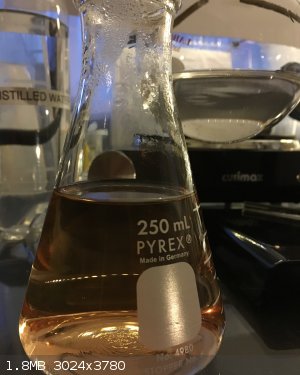Abromination
Hazard to Others
  
Posts: 432
Registered: 10-7-2018
Location: Alaska
Member Is Offline
Mood: 1,4 tar
|
|
Salicylic Acid from Northen Willow Bark
I recently became interested in a shrubby plant that commonly grows around my state called Northern Willow. It is similar to most other willows in
that it contains a high amount of salicylic acid in its bark and have been working on extracting it. The process has had varying succes and I am not
quite done yet but am hoping that I can get at least a little but of the salicylic acid out. I started off by removing the inner bark of the willow,
where most of the SA would be and let this dry for about a week. The bark was then shredded and added to a flask. I added a decent amount of
isopropanol to remove chlorophyll and other contaminants and put the mixture on reflux for a few hours. The isopropanol was transfered to a smaller
flask to be distilled for another clean up and I found it interesting how green the mixture was. The chlorophyll is currently my biggest issue as a
little bit always seems to remain and contaminate the final product, but im making due and will figure that out later. The bark, somewhat cleaner was
then allowed to dry and was transferred to a new flask. A copious amount of acetone, purified by distillation and salted out with sodium sulfate was
then added to the bark and a process similar to what I did with the isopropanol resulted in what should be my SA but is still very contaminated with
chlorophyll. I just thought this was a rather interesting project that might as well be shared.
 
List of materials made by ScienceMadness.org users:
https://docs.google.com/spreadsheets/d/1nmJ8uq-h4IkXPxD5svnT...
--------------------------------
Elements Collected: H, Li, B, C, N, O, Mg, Al, Si, P, S, Fe, Ni, Cu, Zn, Ag, I, Au, Pb, Bi, Am
Last Acquired: B
Next: Na
-------------- |
|
|
ninhydric1
Hazard to Others
  
Posts: 345
Registered: 21-4-2017
Location: Western US
Member Is Offline
Mood: Bleached
|
|
Have you tried recrystallizing the crude salicylic acid in hot water? Maybe that will help remove the chlorophyll.
The philosophy of one century is the common sense of the next.
|
|
|
Magpie
lab constructor
    
Posts: 5939
Registered: 1-11-2003
Location: USA
Member Is Offline
Mood: Chemistry: the subtle science.
|
|
You can also try adding activated charcoal, available at your health food store. Then filter off the charcoal.
The single most important condition for a successful synthesis is good mixing - Nicodem
|
|
|
digga
Harmless

Posts: 39
Registered: 11-6-2018
Member Is Offline
|
|
Please consider sublimation of the crude product. The Wikipedia entry states that salicylic acid sublimes at 76C. This temperature is easily
exceeded in a boiling water bath. You should be able to use a cold finger or lid to capture a purified product.
|
|
|
fusso
International Hazard
    
Posts: 1922
Registered: 23-6-2017
Location: 4 ∥ universes ahead of you
Member Is Offline
|
|
Quote: Originally posted by digga  | | Please consider sublimation of the crude product. The Wikipedia entry states that salicylic acid sublimes at 76C. This temperature is easily
exceeded in a boiling water bath. You should be able to use a cold finger or lid to capture a purified product. |
No, citing pubchem is right, but the wiki editor got the temperature wrong.
|
|
|
digga
Harmless

Posts: 39
Registered: 11-6-2018
Member Is Offline
|
|
Technical-grade salicylic acid obtained from the Kolbe-Schmitt process is already extremely pure: salicylic acid content 99.5%; phenol,
p-hydroxybenzoic acid, or 4-hydroxyisophthalic acid 0.05 - 0.1% (as impurity); ash < 0.1%; water 0.2%. An even higher quality acid (pharmaceutical
grade) can be obtained by crystallizing the sodium salicylate from water at a temperature not exceeding 20 deg C, or by sublimation of the acid at 20
mbar and a temperature of 154 deg C or with the aid of a carrier gas. A more modern process achieves sublimation directly by utilizing the heat of
neutralization from the reaction of sodium salicylate with hydrogen chloride.
Ullmann's Encyclopedia of Industrial Chemistry. 6th ed.Vol 1: Federal Republic of Germany: Wiley-VCH Verlag GmbH & Co. 2003 to Present, p. V31 723
(2003)
|
|
|
Abromination
Hazard to Others
  
Posts: 432
Registered: 10-7-2018
Location: Alaska
Member Is Offline
Mood: 1,4 tar
|
|
Thanks, I will consider all if these and suppose I will have to be careful to keep the product from sublimating in the extraction process.
List of materials made by ScienceMadness.org users:
https://docs.google.com/spreadsheets/d/1nmJ8uq-h4IkXPxD5svnT...
--------------------------------
Elements Collected: H, Li, B, C, N, O, Mg, Al, Si, P, S, Fe, Ni, Cu, Zn, Ag, I, Au, Pb, Bi, Am
Last Acquired: B
Next: Na
-------------- |
|
|
UC235
National Hazard
   
Posts: 565
Registered: 28-12-2014
Member Is Offline
Mood: No Mood
|
|
Have you considered that willow bark contains not salicylic acid, but a glucoside of salicylyl alcohol, called salicin. It's metabolized to salicylic
acid after ingestion.
|
|
|
Abromination
Hazard to Others
  
Posts: 432
Registered: 10-7-2018
Location: Alaska
Member Is Offline
Mood: 1,4 tar
|
|
Apon further research, you are correct, the bark contains salicin. This is a good example of why to check your sources. I can not find much
information on the solubility of this compound, but would it be soluble in acetone or isopropanol? Also, the shape of the molecule makes me feel like
this should be a liquid at ST&P, but I am probably wrong. What physical properties would it have?
List of materials made by ScienceMadness.org users:
https://docs.google.com/spreadsheets/d/1nmJ8uq-h4IkXPxD5svnT...
--------------------------------
Elements Collected: H, Li, B, C, N, O, Mg, Al, Si, P, S, Fe, Ni, Cu, Zn, Ag, I, Au, Pb, Bi, Am
Last Acquired: B
Next: Na
-------------- |
|
|
Tsjerk
International Hazard
    
Posts: 3022
Registered: 20-4-2005
Location: Netherlands
Member Is Offline
Mood: Mood
|
|
According to wiki salicin is soluble in water at 4.3 g/100 mL (no temperature mentioned, but I guess RT). I would start with a water extraction.
Also check this: http://www.sciencemadness.org/talk/viewthread.php?tid=17786
After a quick search I would say extract with water, hydrolyze/oxidize (reflux with 1% for a couple of hours or so) with HCl and crystallize the
salicylic acid (soluble at 2g/L). If the first water extract is green you could use activated carbon as suggested above before hydrolysis.
Edit: For the oxidation I don't know what would be best... hot or cold air exposure. Boiling drives of all oxygen, oxygen dissolves best at low
temperatures.
Maybe best would be first to reflux to hydrolyze the salicin, then stir for a couple of hours at RT. Apparently salicylic alcohol is very prone to
oxidation when exposed to air.
[Edited on 23-10-2018 by Tsjerk]
|
|
|
Herr Haber
International Hazard
    
Posts: 1236
Registered: 29-1-2016
Member Is Offline
Mood: No Mood
|
|
Abromination: cool project.
Especially cool since you can involve your parents in it. I remember your first posts and hopes this will make things easier for you and your hobby.
Otherwise, spending time in the woods with the parents is also nice 
|
|
|
Abromination
Hazard to Others
  
Posts: 432
Registered: 10-7-2018
Location: Alaska
Member Is Offline
Mood: 1,4 tar
|
|
I am attempting an extraction with water and then base hydrolysis, I dont have HCl. This is just a small scale test for now, good chance it wont work.
Ill then let the SA sublimate and crystalize in the flask.
List of materials made by ScienceMadness.org users:
https://docs.google.com/spreadsheets/d/1nmJ8uq-h4IkXPxD5svnT...
--------------------------------
Elements Collected: H, Li, B, C, N, O, Mg, Al, Si, P, S, Fe, Ni, Cu, Zn, Ag, I, Au, Pb, Bi, Am
Last Acquired: B
Next: Na
-------------- |
|
|
Tsjerk
International Hazard
    
Posts: 3022
Registered: 20-4-2005
Location: Netherlands
Member Is Offline
Mood: Mood
|
|
Base hydrolysis should work just as well.
Edit: although for crystallization you need an acid anyhow, as sodium salicylate is soluble at 25 grams per 100 ml.
What are you going to use as a base? If it is an hydroxide you better don't boil it all the way down to sublime the salicylic acid in glass you don't
want to ruin.
[Edited on 24-10-2018 by Tsjerk]
|
|
|
Abromination
Hazard to Others
  
Posts: 432
Registered: 10-7-2018
Location: Alaska
Member Is Offline
Mood: 1,4 tar
|
|
I have been thinking about glassware destruction, but will figure that out later. Who knows, I might just do it in a stainless steel can.
List of materials made by ScienceMadness.org users:
https://docs.google.com/spreadsheets/d/1nmJ8uq-h4IkXPxD5svnT...
--------------------------------
Elements Collected: H, Li, B, C, N, O, Mg, Al, Si, P, S, Fe, Ni, Cu, Zn, Ag, I, Au, Pb, Bi, Am
Last Acquired: B
Next: Na
-------------- |
|
|
Abromination
Hazard to Others
  
Posts: 432
Registered: 10-7-2018
Location: Alaska
Member Is Offline
Mood: 1,4 tar
|
|
Well, I am going to finish this up today. I finally got my HCl, so I wont have to worry about glassware destruction. First, I will clean it up with
activated carbon, and then Ill add about 15 mL 20% HCl to the solution and reflux. Ill isolate the product from that.
List of materials made by ScienceMadness.org users:
https://docs.google.com/spreadsheets/d/1nmJ8uq-h4IkXPxD5svnT...
--------------------------------
Elements Collected: H, Li, B, C, N, O, Mg, Al, Si, P, S, Fe, Ni, Cu, Zn, Ag, I, Au, Pb, Bi, Am
Last Acquired: B
Next: Na
-------------- |
|
|
Tsjerk
International Hazard
    
Posts: 3022
Registered: 20-4-2005
Location: Netherlands
Member Is Offline
Mood: Mood
|
|
Cool! Keep us informed.
To what quatities / volumes are you going to add the 15 milliliters?
|
|
|
Abromination
Hazard to Others
  
Posts: 432
Registered: 10-7-2018
Location: Alaska
Member Is Offline
Mood: 1,4 tar
|
|
The 15 mL of hydrochloric acid were added to about 250 mL water, which contained the salicin. The solution was refluxed for around 30 minutes, and now
all I need to do is oxidise the salicyl alchohol to salycilic acid, which should crystalize out due to its low solubility in water. Without explaining
the full mechanism, the salicin is hydrolysed to form glucose and salycil alcohol. Ill include a pic of the salicil alcohol solution, all though it
is still discolered. That doesn't particularly matter to me though, its easy enough to just hydrolyze ASA for a pure product.

EDIT: Well, I started to pump some air into the alcohol solution and it looks like it worked, although so far I only have a few, discollered small
crystals, and I don't believe that my camera can catch them. I wil leave it out in a beaker for a few days to fully oxidize the alchohol.
[Edited on 12-11-18 by Abromination]
List of materials made by ScienceMadness.org users:
https://docs.google.com/spreadsheets/d/1nmJ8uq-h4IkXPxD5svnT...
--------------------------------
Elements Collected: H, Li, B, C, N, O, Mg, Al, Si, P, S, Fe, Ni, Cu, Zn, Ag, I, Au, Pb, Bi, Am
Last Acquired: B
Next: Na
-------------- |
|
|
Abromination
Hazard to Others
  
Posts: 432
Registered: 10-7-2018
Location: Alaska
Member Is Offline
Mood: 1,4 tar
|
|
Quote: Originally posted by orvilleredenbacher_2  | Have you tried adding NaCl to make the magnesium containing chlorophyll less soluble in water and alcohols?
By the way, leaves of 'Black Bark Willow' are about 50% penicillin. |
I already finished this project, it worked and I have no particular reason to re try it as it was a research project for extra credit on a final.
List of materials made by ScienceMadness.org users:
https://docs.google.com/spreadsheets/d/1nmJ8uq-h4IkXPxD5svnT...
--------------------------------
Elements Collected: H, Li, B, C, N, O, Mg, Al, Si, P, S, Fe, Ni, Cu, Zn, Ag, I, Au, Pb, Bi, Am
Last Acquired: B
Next: Na
-------------- |
|
|
Tsjerk
International Hazard
    
Posts: 3022
Registered: 20-4-2005
Location: Netherlands
Member Is Offline
Mood: Mood
|
|
I didn't see your new posts till now, how much SA did you get out? And how much bark did you start with?
|
|
|
Abromination
Hazard to Others
  
Posts: 432
Registered: 10-7-2018
Location: Alaska
Member Is Offline
Mood: 1,4 tar
|
|
Quote: Originally posted by Tsjerk  | | I didn't see your new posts till now, how much SA did you get out? And how much bark did you start with? |
I only gota few crystals out and lost the amount of bark that I had started with. I had messed up an earlier step in the process and it was too late
to gather more bark ( the salicin concentration drops a lot during the winte). I did not get a significant amount of SA out of it although that was
expected, even if I hadn't messed it up a bit, although it was the process itself that really mattered to me. It isn't often I work with plants so
this was really a new experience. Maybe I will retry it in the spring for the fun of it.
List of materials made by ScienceMadness.org users:
https://docs.google.com/spreadsheets/d/1nmJ8uq-h4IkXPxD5svnT...
--------------------------------
Elements Collected: H, Li, B, C, N, O, Mg, Al, Si, P, S, Fe, Ni, Cu, Zn, Ag, I, Au, Pb, Bi, Am
Last Acquired: B
Next: Na
-------------- |
|
|
j_sum1
|
Thread Split
23-1-2019 at 17:42 |
|